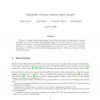17 search results - page 1 / 4 » Randomly coloring sparse random graphs with fewer colors tha... |
RSA
2006
13 years 4 months ago
2006
We analyze Markov chains for generating a random k-coloring of a random graph Gn,d/n. When the average degree d is constant, a random graph has maximum degree (log n/ log log n), ...
STOC
2007
ACM
14 years 5 months ago
2007
ACM
STOC
2002
ACM
14 years 5 months ago
2002
ACM
We analyze a randomized version of the Brelaz heuristic on sparse random graphs. We prove that almost all graphs with average degree dp4:03; i.e., G?n; p ? d=n?; are 3-colorable a...
FOCS
2004
IEEE
13 years 8 months ago
2004
IEEE
We study a simple Markov chain, known as the Glauber dynamics, for generating a random k-coloring of a n-vertex graph with maximum degree . We prove that, for every > 0, the d...
MST
2010
13 years 3 months ago
2010
Coloring a k-colorable graph using k colors (k ≥ 3) is a notoriously hard problem. Considering average case analysis allows for better results. In this work we consider the unif...

